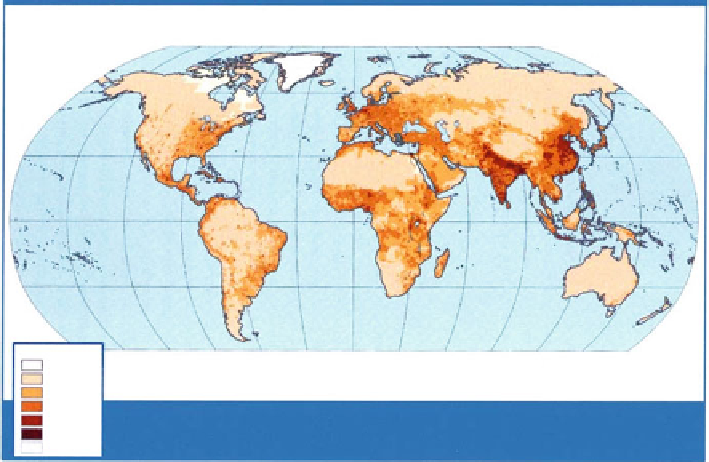Geoscience Reference
In-Depth Information
Persons / sq km
0
1-4
5-24
25-249
250-999
1000+
no data
Fig. 20.2
Projected global population density in 2015
prevent desertification and protect the artificial oasis (see below) and the associated
urban settlements. Apart from extending the water distribution to sites for tree
planting little else seems to be done by Forestry bureaus to control desertification in
the rangelands (a major source of dust in dust storms that are a scourge in spring) and
whose presence regularly plagues the east coast cities such as Beijing and Tianjin
(Yang Youlin et al.
2002
). Measures designed to prevent sand encroachment are
quite ineffective against dust storms. The finer particle size that characterize the
sediment in dust storms derives from the rangelands and croplands where it is lifted
and transported at a height far in excess of that of any tree barrier. Sand on the other
hand, is rarely lifted above 0.5 m above the ground and is transported by a quite
different mechanism (Squires
2002
). Trees and shrubs that are planted in strategic
A feature of much of the tree planting effort so evident in China today is that
follow-up is poor or completely neglected. The enthusiasm of people to volunteer
to dig the holes and plant the trees is high. The maintenance of the plantings is
neglected and many trees die because of lack of water (Fig.
20.3
).
Tree spacing is too close in many instances and the sustainability of such
plantings must be seriously questioned. The research institutes within the Forestry
sector seem to be providing answers to questions that no one is asking. Practical
applied research (problem oriented) is absent or weakly expressed (Lu et al.
2006
).
One of the research institutes with the longest history in desert control is the Gansu
Desert Control Research Institute in Wu Wei in the Hexi Corridor. It was established

Search WWH ::

Custom Search